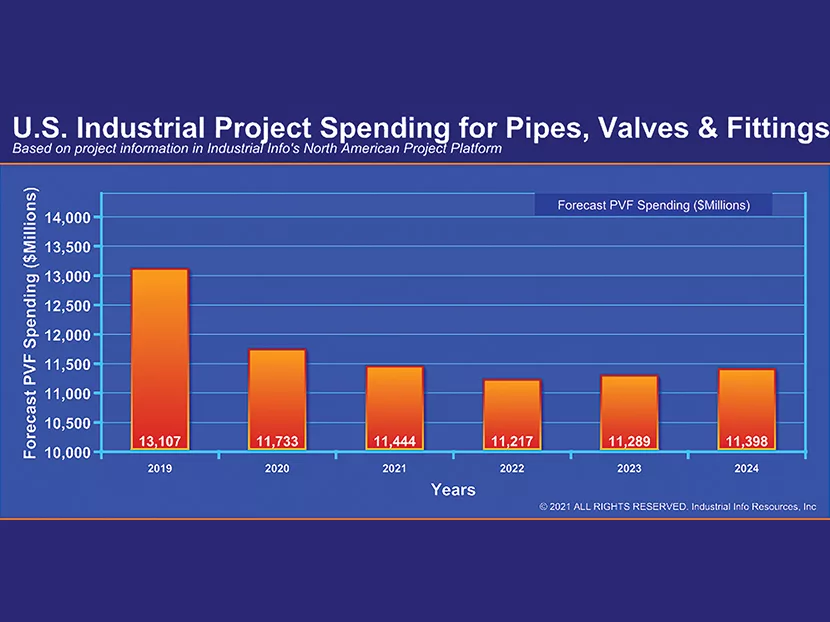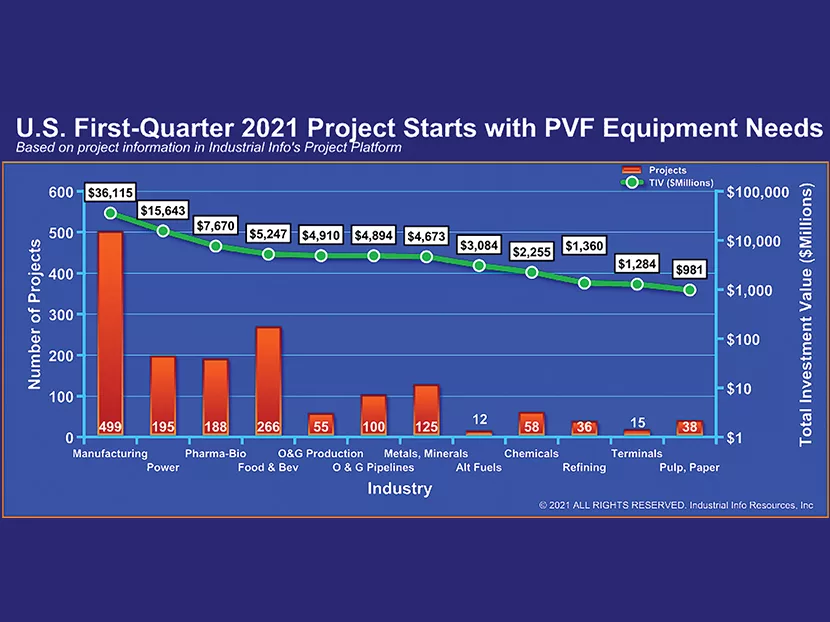By anybody’s reckoning, the year 2020 was a doozy when it came to the economy, politics and, of course, public health. In general, project activity among the industries tracked by Industrial Info Resources continues to climb out of the economic hole caused by the COVID-19 pandemic this year, but the going is arduous.
Even so, pipe, valves and fittings are listed among the key equipment needs for a wide variety of projects in various stages of development.
U.S. industrial spending on PVF reached a 12-year high in 2019, at more than $13.1 billion, but fell sharply to about $11.7 billion in 2020, according to IIR’s Forecast Analyzer. That amount is predicted to drop somewhat further in 2021 and 2022 before starting to rise again in 2023 (see Figure 1).
PVF equipment is listed among the key equipment needs for more than $88 billion worth of U.S. capital projects planned to start construction in the first quarter of 2021.
Not all projects will move forward as planned. Nearly $9 billion worth of the projects has been assessed as having a low probability (0 to 69 percent) chance of moving forward. The remaining $79 billion in projects were assessed as either having a medium (70 to 80 percent) or a high (81 to 99 percent) probability.
Figure 2 shows planned first-quarter, PVF-related project kickoffs among the 12 industries tracked by IIR.
Industrial Manufacturing Bright Spots
Covering a wide range of sectors, industrial manufacturing industry project starts planned for the first quarter easily take first place when it comes to PVF equipment needs.
COVID-19 did a number on this sector last year. Still, the project spending impact was not as large as first anticipated as the vast majority of projects affected were delayed rather than canceled. However, the pandemic's effects are expected to be longstanding, with COVID-19 expected to remain a significant issue through 2021. Until a vaccine is effectively distributed, companies will have to deal with potential outbreaks and shutdowns.
The industry sees larger spending numbers projected for 2021, but project development will be a little slower as the industry takes a breath and examines what plans it wants to push forward in these uncertain times. In 2020, the industry saw $72 billion in capital and maintenance projects begin construction in North America. An additional $104 billion in projects is scheduled to start construction in 2021.
The National Association of Manufacturers’ final Manufacturers’ Outlook Survey for 2020 showed optimism, climbing from its low in the second quarter brought on by the COVID-19 pandemic. In the fourth quarter, 74.2 percent of manufacturers responding to the survey felt positive about their own company’s outlook, up from 66 percent in the third quarter. However, a wide gap remained between the fourth-quarter 2020 numbers and the 90 percent average in 2019.
The automotive sector is one of the larger spending sectors in the industry; however, following years of record sales and production numbers, the momentum has turned and things are slowing down. This was expected to happen, given the numbers the sector has seen for several years, but COVID-19 and the resulting shutdowns have somewhat accelerated it.
Much of the disposable income once available to consumers has disappeared during the pandemic. In 2020, the automotive sector saw spending that topped only the $13 billion mark, several billion less than in previous years.
Looking at 2021, only an additional $8.5 billion in automotive projects are scheduled to take place, according to IIR’s database. Depending on how the COVID-19 situation progresses, that number may decline.
The sector also is seeing a shift in the types of projects expected to kick off. Gone are the days of a large number of grassroot plants being planned in a given year. Most of the capital-spending projects set for 2021 will revolve around expansions, upgrades, renovations and modifications.
One potential exception is re-shoring as the automotive sector looks at ways to resolve overseas supply-chain problems that arose during the pandemic. The expected downturn in overall automotive spending should continue into 2022.
One of the brightest sectors within the industrial manufacturing industry in recent years is data centers. Spending has been on the rise even with the COVID-19 pandemic. This sector is expected to continue its strong spending habits heading into 2021; this trend likely will continue for several years. The cornerstone of surviving the COVID-19 pandemic has been the ability to work or learn online.
The distribution and warehousing sector has seen substantial growth in the past decade, which is expected to continue into 2021, with online purchasing becoming the go-to shopping method. To accommodate the shift to online purchasing, logistics networks were forced to expand.
The bulk of the expansion within this sector has revolved around the larger, regional distribution facilities serving as the hubs of distribution for various companies. The focus has shifted to smaller, localized distribution facilities that can more rapidly deliver products.
The transportation systems sector, including freight and passenger rail, inland and deepwater ports, and airport infrastructure, is the largest spender in the industrial manufacturing industry, simply because of the size and cost of the projects.
In 2020, the transportation systems sector saw $23 billion in project activity begin construction in North America. Looking ahead to 2021, the projected spending climbs to $66 billion worth of planned projects.
For the first 51 weeks of 2020, U.S. railroads reported cumulative volume was down 13.2 percent from the same point last year, according to the American Association of Railroads. However, combined U.S. carload and intermodal traffic in November 2020 were up 3.1 percent from November 2019 as the freight rail sector continued to make up lost ground from the lower traffic rates earlier in the year.
Power Activity
Most new-build power project activity in 2021 will remain in the renewable and natural-gas-fired power generation realm. The U.S. Energy Information Administration (EIA) forecasts that total U.S. power demand will drop to 3,730 billion kilowatt-hours (kWh) in 2020, from 3,896 billion kWh in 2019, before rising to 3,785 billion kWh in 2021. That compares with an all-time high of 4,003 billion kWh in 2018.
The fall in demand in 2020 has resulted in some planned capex spending to be put off, delayed or, in some cases, canceled. COVID-19 has caused delays and disruptions to project planning, implementation and execution. Whether caused by governmental or workforce issues, projects have had delays ranging from four months to two years in execution.
COVID-19 is likely to remain a major player in the spending and construction of projects in 2021. Maintenance programs, decommissioning, environmental, plant conversions and life extension projects are some of the focus areas.
The nuclear generation sector has been shored up in some states through legislative action that includes nuclear energy as a part of clean-energy plans, allowing some nuclear energy plants to continue operating beyond their current licensing period. However, nuclear power’s competition with renewable energy and natural gas generation brings challenges in the near future.
Long-term estimates state more than one-third of operational U.S. nuclear plants are at risk of closure for economic reasons within 10 years. There are 17 states with 21 operational but uneconomic plants already scheduled to close. The EIA indicates that nine plants with 11 gigawatts announced they intend to retire by 2025.
The outlook for coal-fired power remains subdued as the prospect for more coal-fired capacity retirements continues. The Environmental Protection Agency tightened coal-ash disposal requirements for certain coal-fired power plants. This prompted several utilities to further solidify their plans to retire and exit their coal-fired capacity, shift toward renewables and add more associated battery storage investment and new capacity.
Natural gas continues to grab the majority of coal’s market share. There is expected to be a modest recovery in coal demand in 2021 due to higher gas prices, but the long-term decline is inevitable. Coal-fired generation is too expensive compared with more efficient, modern combined-cycle plants. The outlook for in-plant capital and plant expansion spending associated with operational gas-fired power plants remains very healthy due to the ongoing buildout in gas-fired fleets across the country.
Renewable energy is still one of the major generation market sectors, with wind and solar generation still leading the way for the foreseeable future. Expectations are that installations across the country might exceed 36 gigawatts in 2021.
Even without tax subsidies, the renewable energy sector is expected to remain healthy. Declining costs of wind and solar power, coupled with several state-level renewable portfolio standard expansions, are expected to drive renewable energy investment well into the future.
Innovations such as battery storage, distributive energy generation, industrial energy producers, and real-time diagnostic and monitoring systems are changing the landscape of the electric utility industry in 2021 and beyond. The development of green hydrogen, or Power-to-X projects, is likely to gain more traction in the United States.





